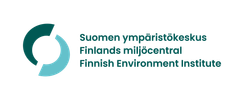Long-term monitoring indicates clear changes in Baltic Sea ecosystem
Oxygen situation in the depths of Finland's southern sea areas has deteriorated. While nutrient loading has been curbed, phosphate phosphorus concentrations have increased over the long term. These changes have also shaped the benthos and zooplankton communities.

Long-term monitoring of the Baltic Sea enables the detection of changes in the state of the sea, and the impacts of water protection measures in the catchment areas can be evaluated. Coastal monitoring also supports the objectives of the Archipelago Sea Programme.
Research vessel Aranda’s monitoring cruise in August was directed to the Gulf of Finland, Archipelago Sea, Northern Baltic Proper and Gulf of Bothnia, while coastal monitoring targeted areas to the west from Inkoo in the Gulf of Finland as well as southeast parts of the Archipelago Sea. On these cruises, a broad range of data is collected on the physical, chemical and biological properties of the Baltic Sea and on harmful substances from the bottom sediment to epilimnion. These observations are used to assess such characteristics as the oxygen situation of the sea, eutrophication and potential changes in plankton communities and benthos.
Poor oxygen situation in the Gulf of Finland in August
In January 2025, oxygen concentrations in the Gulf of Finland were good from surface to bottom. This is an exceptional situation which, in the 2000s, has always been brought about by a long period of westerly winds during winter. In these conditions, the halocline sinks deeper and the zone of anoxic deep water from the main basin of the Baltic Sea retreats to the west, further away from the Gulf of Finland. As the weather type changes the oxygen situation in the Gulf of Finland often deteriorates rapidly, which had also happened this year by the time of Aranda’s cruise in early summer. The oxygen situation in the deeps of the Gulf of Finland remained poor in August.
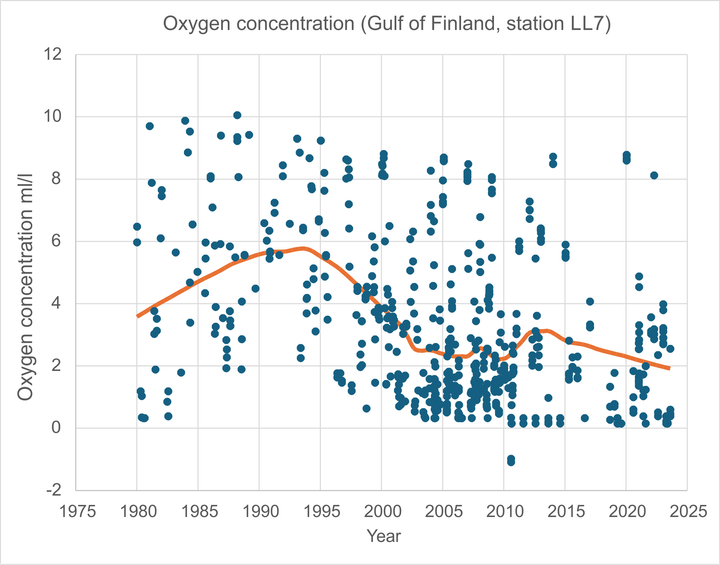
Phosphorus concentration continues to rise despite reduced nutrient load
While the nutrient loads carried into the Baltic Sea and especially the Gulf of Finland have clearly decreased in the 2000s, the phosphorus concentration has continued to rise and the oxygen situation to deteriorate, especially in Finland's southern sea areas. The increased phosphorus concentration is explained by the influx of nutrients from the main basin of the Baltic Sea, especially in the Gulf of Finland but also in the Bothnian Sea and Bothnian Bay.
“The halocline in the Baltic Sea's main basin has risen higher since the early 1990s, and major salt pulses have enhanced the stratification. An expanding area of the seabed has been exposed to hypoxia, and phosphorus release from the bottom sediment has increased. Phosphorus from the main basin is also carried to Finnish sea areas,” says Senior Researcher Seppo Knuuttila.
In terms of eutrophication, the status of all coastal waters in Finland is poor. Any improvement in this situation can only be detected in areas that experienced heavy urban and industrial wastewater loading in the past. Today, the largest share of anthropogenic nutrient loading in the sea comes from agriculture and forestry in all Finnish sea areas. No marine area has seen a decrease in the phosphorus and nitrogen loads from these sources over the long term.
"On the recently completed coastal monitoring cruise, the impact of an excessive nutrient load could, among other things, be seen as oxygen depletion in near-bottom waters. The oxygen situation was poor even in some very shallow water areas,” says Seppo Knuuttila.

The Baltic Sea's ecosystem has changed
The benthos and zooplankton communities in Finland's sea areas have undergone significant changes over the past 40 years. The situation is the worst in the Gulf of Finland.
Due to oxygen depletion, benthic animals are scarce in the Gulf of Finland. Most recently, the benthos was able to recover in the early 1990s as salinity stratification declined and the water column was regularly mixed, temporarily improving the oxygen situation in the depths. Since the late 1990s, no longer periods of better oxygen conditions have occurred, which has prevented the recovery of the benthic community.
Zooplankton communities in the Gulf of Finland have changed considerably. Zooplankton biomass has decreased overall, with a negative impact on energy transfer from primary producers (phytoplankton) to higher levels of the food network, including fish. This unfavourable situation continued for around two decades (2003–2023) but appears to have improved over the past year.
“Large copepods, which provide the main food source for plankton-eating fish, appear to have increased their share in the offshore community. While this change is a hopeful sign indicating that a crucial link in the offshore food network could be recovering, only the years to come will show if the change for the better continues,” says Research Professor Maiju Lehtiniemi.
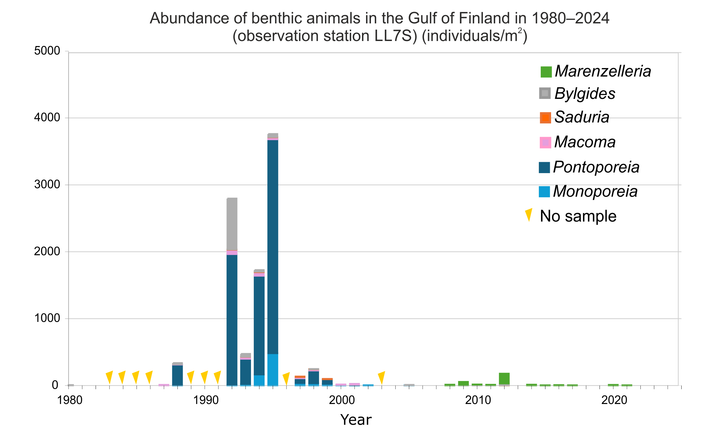
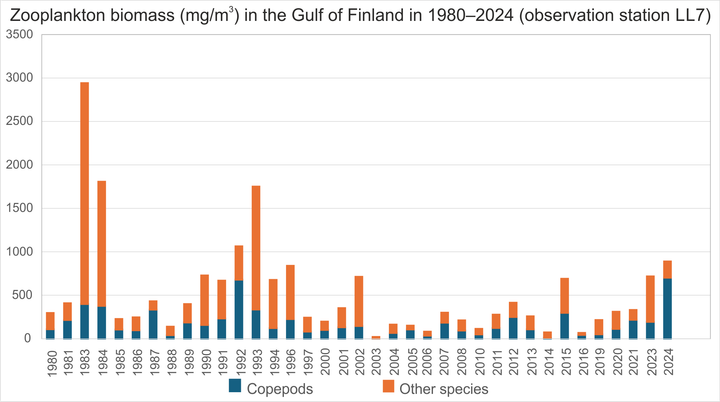
In the Bothnian Sea, the benthic community has changed in the 2000s. The natural Monoporeia affinis cycles have declined. The probable reason for this is changes in primary production in the water column that have impaired the quality of food suitable for these amphipods sinking to the bottom. Marenzelleria spp., which is an invasive alien species, has become established in the Bothnian Sea in the 2000s and diversified the structure of the benthos. Marenzelleria have both a positive and a negative impact on the seabed habitat as they burrow in and stir up the bottom sediment.
While the zooplankton biomass has also varied in the Bothnian Sea, no alarming decrease in total biomass has been observed there. The greatest change of recent years in the Bothnian Sea has been the increase of small zooplankton, such as rotifers and daphnia. If small planktonic organisms continue to increase in numbers, this will have an adverse effect on the food supply of fish feeding on plankton, including the herring and sprat.
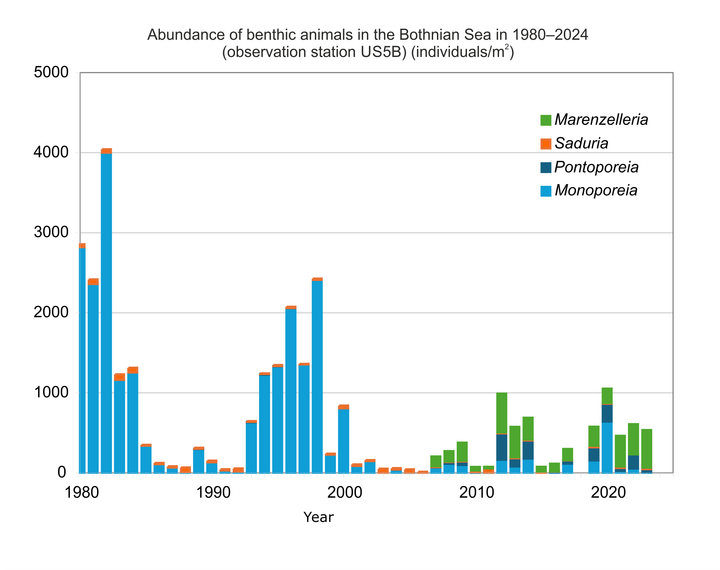
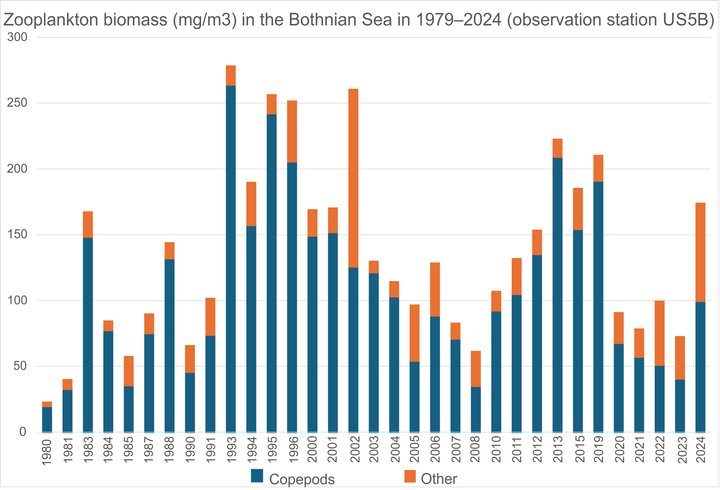
Keywords
Contacts
Coastal monitoring, Special Researcher Seppo Knuuttila, tel. 0295 251 286, firstname.lastname@syke.fi
Chief scientist on Aranda (Gulf of Finland) and zooplankton: Research Professor Maiju Lehtiniemi, tel. 0295 251 356, firstname.lastname@syke.fi
State of the seabeds and benthic fauna, Special Researcher Henrik Nygård, tel. 0295 251 469, firstname.lastname@syke.fi
Chief scientist on Aranda (Bothnian Sea and Baltic Proper), Senior Researcher Pekka Kotilainen, tel. 0295 251 317, firstname.lastname@syke.fi
Communications Specialist Eija Järvinen, tel. +358 295 251 242, firstname.lastname@syke.fi
Media service at Finnish Environment Institute
Our Media Service provides information on research, helps journalists find experts for interviews and provides photos for media use.
Our Communication experts will answer your inquiries on weekdays from 9 am to 4 pm.
Images
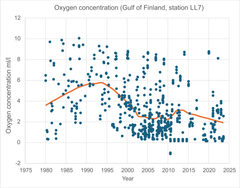

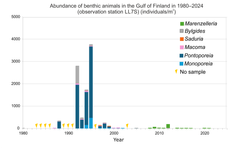
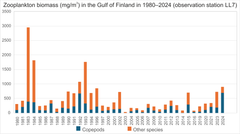
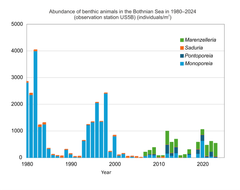
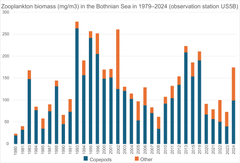
Finnish Environment Institute - We build hope through research.
Finnish Environment Institute
Latokartanonkaari 11
00790 Helsinki
+358 295 251 000
It is time to move beyond solving environmental problems one by one, to systemic sustainability transformations. The Finnish Environment Institute (Syke) contributes to building a sustainable society through research, information and services. The Finnish Environment Institute is a research institute with 700 experts and researchers located in Helsinki, Oulu, Jyväskylä and Joensuu.

Subscribe to releases from Suomen ympäristökeskus
Subscribe to all the latest releases from Suomen ympäristökeskus by registering your e-mail address below. You can unsubscribe at any time.
Latest releases from Suomen ympäristökeskus
Viikkokatsaus 24.–28.11.202520.11.2025 11:57:48 EET | Tiedote
Hei! Tässä tiedoksesi meillä Suomen ympäristökeskuksessa ensi viikolla ilmestyviä tiedotteita, uutisia, kampanjoita, blogeja ja uutiskirjeitä. Mukana myös tulevia tapahtumia ja webinaareja. Jakelemme viikkokatsauksen torstaisin STT:n kautta. Koosteet löytyvät myös STT-uutishuoneesta, josta voit tilata kaikki Suomen ympäristökeskuksen tiedotteet.
Proposal for saving the Baltic Sea: 34 actions to strengthen the network of marine protected areas18.11.2025 10:00:00 EET | Press release
Joint press release from Metsähallitus and Finnish Environment Institute Baltic Sea nature is threatened by eutrophication, pollution and climate change. The Roadmap for the development of marine protected area network in Finland until 2030, which was drawn up in cooperation between a number of organisations, presents 34 actions for improving the status of the Baltic Sea, safeguarding the most valuable marine areas and achieving international conservation area targets. Never before has an equally extensive and comprehensive plan for the conservation of marine nature been drawn up in Finland.
Plan för att rädda Östersjön: 34 åtgärdsförslag för att stärka nätverket av marina skyddsområden18.11.2025 10:00:00 EET | Pressmeddelande
Forststyrelsen och Finlands miljöcentral meddelar: Östersjöns natur hotas av eutrofiering, föroreningar och klimatförändringen. Färdplan för utvecklingen av Finlands nätverk av marina skyddsområden fram till 2030, som utarbetats i samarbete mellan flera organisationer, innehåller 34 konkreta åtgärder för att förbättra havets tillstånd, skydda de mest värdefulla havsområdena och uppnå internationella mål för skyddsområdena. En så omfattande och heltäckande plan för skydd av den marina naturen har aldrig tidigare tagits fram.
Suunnitelma Itämeren pelastamiseksi: 34 toimenpide-ehdotusta merensuojelualueverkoston vahvistamiseksi18.11.2025 10:00:00 EET | Tiedote
Suomen ympäristökeskus ja Metsähallitus tiedottavat: Itämeren luontoa uhkaavat rehevöityminen, saastuminen ja ilmastonmuutos. Useiden organisaatioiden yhteistyönä laadittu Suomen merensuojelualueverkoston kehittämisen tiekartta vuoteen 2030 esittää 34 konkreettista toimenpidettä, joilla voidaan parantaa meren tilaa, turvata arvokkaimmat merialueet ja saavuttaa kansainväliset suojelualuetavoitteet. Yhtä laajaa ja kattavaa suunnitelmaa meriluonnon suojelusta ei ole aiemmin tehty.
Viikkokatsaus 17.–21.11.202513.11.2025 12:45:29 EET | Tiedote
Hei! Tässä tiedoksesi meillä Suomen ympäristökeskuksessa ensi viikolla ilmestyviä tiedotteita, uutisia, kampanjoita, blogeja ja uutiskirjeitä. Mukana myös tulevia tapahtumia ja webinaareja. Jakelemme viikkokatsauksen torstaisin STT:n kautta. Koosteet löytyvät myös STT-uutishuoneesta, josta voit tilata kaikki Suomen ympäristökeskuksen tiedotteet.
In our pressroom you can read all our latest releases, find our press contacts, images, documents and other relevant information about us.
Visit our pressroom